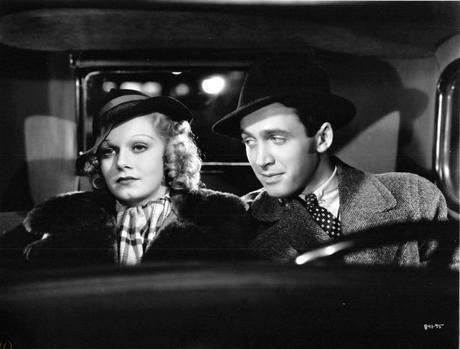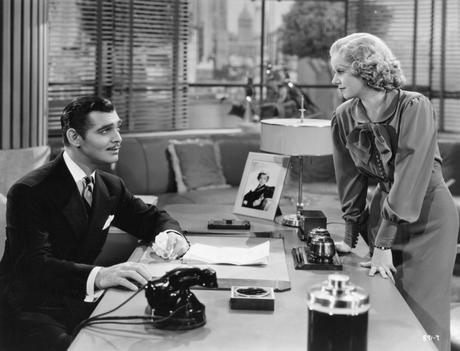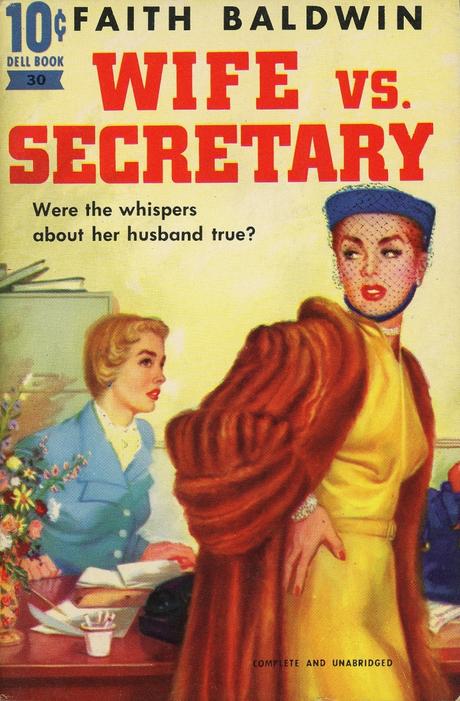
When the movie Wife vs. Secretary was released in 1936, it represented a big turning point in the career of Jean Harlow. In the early 1930s, she was famous for her bombshell image, exemplified by her performances as characters like Vantine in Red Dust, Kitty Packard in Dinner at Eight, and Lil in Red-Headed Woman. But by the mid-1930s, it was time for a change and her on-screen image began to soften. In Red-Headed Woman, she played a secretary who relentlessly pursued her married boss and broke up his marriage. But Helen, her character in Wife vs. Secretary, was the complete antithesis of Lil from Red-Headed Woman.
In Wife vs. Secretary, Jean Harlow plays Helen, the faithful secretary to Van Stanhophe, played by Clark Gable. Despite rumors and speculation about Helen’s relationship with her boss, Van is very happily married and is faithful to his wife Linda, played by Myrna Loy. Linda has no reason not to believe that Van and Helen’s relationship is strictly business, but over time, comments made by other people begin to erode her confidence and it eventually takes a toll on their marriage.
Before Wife vs. Secretary was a hit movie, it was a popular story by Faith Baldwin, originally published in Cosmopolitan magazine in 1935. So, how do the book and the movie compare?
Book & Movie Differences
Overall, Wife vs. Secretary pretty closely follows the core story laid out in the book. It doesn’t follow the book to the letter, but most of the main plot points are there. However, there are some very significant changes, particularly involving the character of Helen’s boyfriend, Dave, played by James Stewart in the movie.

In the movie, we see that Dave is extremely insecure about Helen’s career and her relationship with Van. When Dave gets a raise at work, the first thing he does after telling her the news is ask her to quit her job so that they can get married. Despite the tension this causes between Helen and Dave, they are able to reconcile their differences. In the book, this story arc is completely different. The book version of Dave feels so insecure about Helen’s relationship with Van that he steals money from the company he works for so that he can buy a new car and seem more impressive to Helen. Of course, Dave gets caught and ends up in a legal mess, which results in Helen getting hit by a car while walking to meet a lawyer because she was so distracted by the situation. When Van finds out, he uses his connections to get the charges against Dave dropped and makes arrangements for him to get a new job in South America so that he can start over, which Dave goes through with.

When we see Helen and Van together in the movie, it’s more clear to viewers that their relationship is strictly business. In the book, more details are included that make the reader question if perhaps there really are deeper feelings between them. For example, early in the story, it’s mentioned that Helen kept newspaper clippings about her boss in a scrapbook. And when Helen is in the hospital, Van goes to visit her and gives her a kiss at one point, which Linda witnesses.
Even though both the book and the movie end in the same general way, with Van and Linda reconciling, how they reach that point differs. In the movie, Helen visits Linda right before Linda is set to leave for a trip and admits that she loves Van but warns Linda that if she leaves now, it’s inevitable that he’s going to rebound with her and he’d never love her as much as he loves Linda. This allows Linda and Van to get back together and sets things up for Helen and Dave to get back together. In the book, Linda shows up at the office and while she’s there, she has a chance to get a glimpse at what Van is like when he’s at work and realizes that who he is at work and who he is when he’s with her are like two different people. Helen admits that she does love Van, but strictly for who he is when he’s at work and she values her job too much to let that change. In the end, Helen and Linda agree that it’s possible for the two of them to love the different sides of the same man while coexisting peacefully. But since Dave went off to South America in the book, Helen doesn’t reconcile with him and instead continues to find more satisfaction in her career than her romantic life.
Is the Book Worth Reading?

Wife vs. Secretary is a total gem of a movie and the book is very enjoyable as well. A very quick, light read that’s perfect for when you’re trying to relax on a hot summer day. If you’re a fan of vintage career girl stories along the lines of The Best of Everything, you’d probably enjoy Wife vs. Secretary. Since I adore the cast of the movie, that remains my favorite version of the story. And when you read the book, it’s easy to see why the main characters were cast the way they were in the movie. Linda in particular was practically written with Myrna Loy in mind. I liked Faith Baldwin’s style of writing so I’m really glad that my copy of the book also included two other novels she wrote so that I can read more of her work.
What I liked most about the book is that Helen is an unapologetic career woman; highly capable at what she does, savvy at handling difficult situations, and loves being able to do it. Depictions of women who highly value their careers are commonplace today, but considering the story Wife vs. Secretary was first published in 1935, Faith Baldwin’s decision to let Helen be so willing to make her career a priority in her life without vilifying her or making her seem cold and heartless in any way was refreshing. In the end, she explains to Linda that when Van succeeds, she feels like she succeeds by extension and she’d rather have 10 years of that than 20 years of being Van’s wife.
Even though I’ve long been a fan of the movie, I always thought the title did it a disservice because a name like Wife vs. Secretary suggests something more slapstick or screwball when the story is really much smarter than that. After reading the book, my opinion of the title remains the same.
This review is part of the 2021 Classic Film Summer Reading Challenge hosted by Out of the Past. For more reviews on books related to classic film, be sure to follow the #ClassicFilmReading hashtag on social media.
